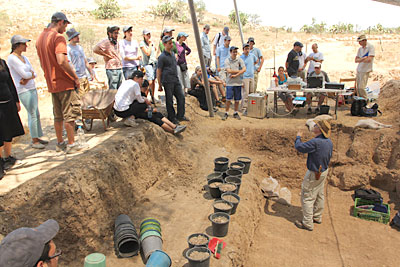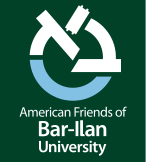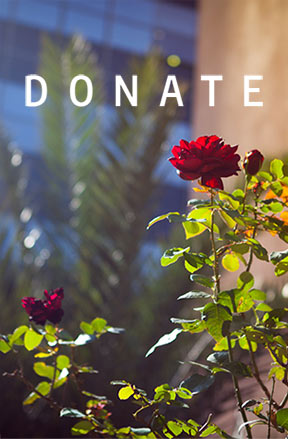Tel Zafit National Park, Israel -
A large contingent of Americans took part in an historic experience this summer by being part of the volunteer team that discovered the fortifications and entrance gate of the biblical city of Gath of the Philistines, home of Goliath and the largest city in the land during the 10th-9th century BCE.
They joined with volunteers from around the world who participated in the recently completed Ackerman Family Bar-Ilan University (BIU) Expedition to Gath, headed by Prof. Aren Maeir, in 20th annual excavation of Tell es-Safi/Gath in the Tel Zafit National Park, located in the Judean Foothills.

Summer interns, including many from the US, dig at Tell es-Safi/Gath – home of the biblical Goliath.
Awe-Inspiring Sense of Discovery
Prof. Maeir, of the Martin (Szusz) Department of Land of Israel Studies and Archaeology at BIU, led the archaeology dig along with US groups from Brigham Young University, Yeshiva University, University of Kansas, Grand Valley State University of Michigan, as well as groups from the University of Melbourne, University of Manitoba, several Korean universities and additional institutions throughout the world.
Miriam Jacobson, a Yeshiva University senior majoring in graphic design, said she was excited about being able to integrate her art skills to provide a different perspective of depicting the dig site. A resident of New York City, Miriam said, “Seeing the gates up-close was really awe inspiring. It was incredible to be in their area where they were unearthed…As someone interested in history, I tremendously enjoyed the environment and sense of discovery.”
David’s Escape from King Saul
According to Prof. Maeir, this is among the largest ancient city gate discoveries ever found in Israel. He said it provides evidence of the status and influence of the city of Gath during this period. In addition to the monumental gate, an impressive fortification wall was discovered, as well as various buildings in its vicinity, such as a temple and an iron production facility. The city gate is referred to in the Bible (in I Samuel 21) in the story of David’s escape from King Saul to Achish, King of Gath.

View of the Iron Age fortifications of the Lower City of Philistine Gath
Dara Stuart, a junior at the University of Kansas in Lawrence, Kansas, said that as exciting as the gate discovery was for her and the group, her personal highlight was finding a pre-Bronze Age pot that was 4,500 years old. “It was the culmination of a wonderful archaeology experience. I got to see the process of how they track archaeological items. This was a notable find, especially since the base of the pot was intact and enough body shards were found to totally restore it.”
The “Goliath Gate” discovery ranks among the most significant findings to date at the site: Philistine Temples dating to the 11th through 9th century BCE, evidence of an earthquake in the 8th century BCE possibly connected to the earthquake mentioned in the Book of Amos I:1, the earliest decipherable Philistine inscription ever to be discovered, which contains two names similar to the name Goliath; and remains of the Crusader castle “Blanche Garde” at which Richard the Lion-Hearted is known to have been, and much more.
A Joy of Making Friends, Learning and Feeling History
Being part of these discoveries every year since she joined the original team in 1996 is Ahuva Ho, of Orange County, California. “I am called justifiably “the Queen of the Tell,” said Ho. She added, “Coming every summer for three weeks is my joy — to work with people I love, meeting new people, making friends, learning and feeling history — the history of my people (the history of the Philistines is intertwined with that of the Israelites).”
A Bible scholar, Ho said, “Standing there, and looking at the gate area, I could visualize young David, knocking on the gates in order to find refuge from his pursuer, King Saul.”
Bob Miller, of Brookline, Massachusetts, said he was taking away a wheelbarrow of dirt from the area when it was confirmed that the gates were exposed. “The whole experience was amazing. I’m still trying to take it all in to find out how it changed me as a person,” said Miller, who has a long-time interest in Biblical Archaeology.
People from Different Backgrounds Working Seamlessly Together
He added, “I have tremendous respect for Prof. Maeir, who was always willing to answer our questions. He is one of the most tireless, passionate individuals I’ve ever met in my life…Even though the work was demanding, I felt good about being part of a team that had a collective purpose. It enabled me to work so much harder than I thought I could.” He added, “People from all different backgrounds, whether they were young Israeli tour guides in training or a group of Evangelical Christians, all worked seamlessly together. It was a completely refreshing experience.”
To learn more about ways that you can support the work of Prof. Maeir and other biblical archealogy work at Bar-Ilan University, contact Howard Charish at howard.charish@afbiu.org.


